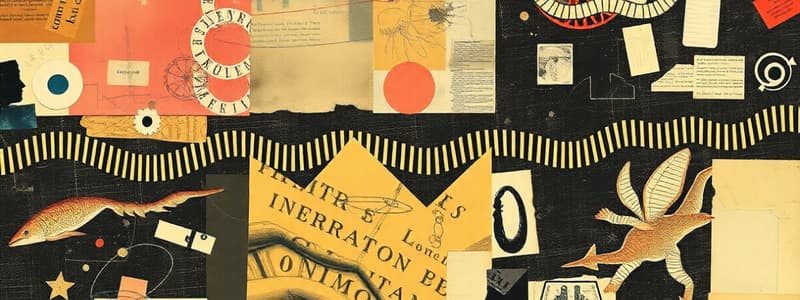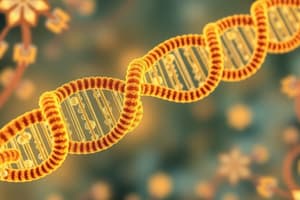Podcast
Questions and Answers
What is the first step in the process of transcription?
What is the first step in the process of transcription?
- The DNA strands are eliminated.
- The ribosome reads the mRNA.
- The helix of DNA is opened up. (correct)
- The mRNA is synthesized from amino acids.
What is created during transcription?
What is created during transcription?
- A strand of DNA
- A new ribosome
- A protein
- A strand of mRNA (correct)
How does the mRNA molecule differ from the DNA template during transcription?
How does the mRNA molecule differ from the DNA template during transcription?
- mRNA is single-stranded. (correct)
- mRNA is double-stranded.
- mRNA does not carry information.
- mRNA contains thymine instead of uracil.
Which base pairs with adenine in mRNA during transcription?
Which base pairs with adenine in mRNA during transcription?
What happens when the enzyme reaches a 'stop' signal during transcription?
What happens when the enzyme reaches a 'stop' signal during transcription?
Where does translation occur?
Where does translation occur?
During translation, how is protein synthesis initiated?
During translation, how is protein synthesis initiated?
What codon typically signals the start of protein synthesis?
What codon typically signals the start of protein synthesis?
How many different amino acids are used to build proteins?
How many different amino acids are used to build proteins?
What role do codons play in the process of translation?
What role do codons play in the process of translation?
Flashcards are hidden until you start studying
Study Notes
DNA, RNA, and Protein Synthesis
- DNA is housed in the nucleus and serves as a template for mRNA synthesis.
- mRNA is synthesized through transcription, where the DNA helix is opened and the gene to be transcribed is exposed.
- Only one DNA strand is used as a template, and the mRNA molecule is single-stranded.
- Transcription involves complementary base pairing: cytosine pairs with guanine, thymine pairs with adenine, and adenine pairs with uracil.
- Transcription ends when the enzyme encounters a "stop" signal, terminating mRNA synthesis.
- mRNA leaves the nucleus through nuclear pores and travels to the ribosomes in the cytoplasm.
- Ribosomes are the sites of protein synthesis, where mRNA information is translated into proteins.
- Ribosomes read the base sequence of mRNA in triplets (codons), each corresponding to a specific amino acid.
- Protein synthesis commences with a start codon and ends with a stop codon.
- Up to 20 different amino acids are used to build proteins.
- Translation occurs on free ribosomes in the cytoplasm and those attached to rough endoplasmic reticulum.
Transcription
- The process of transcribing DNA into mRNA.
- The DNA molecule is unwound to expose the bases, and only the gene to be transcribed is opened.
- The enzyme involved in mRNA synthesis reads only one DNA strand.
- Complementary base pairing occurs between the DNA template and the newly synthesized mRNA.
- Transcription stops once the enzyme encounters a "stop" signal.
Translation
- The process of translating mRNA into proteins.
- Occurs in the cytoplasm on ribosomes.
- Ribosomes read the mRNA sequence in triplets (codons).
- Each codon corresponds to a specific amino acid.
- Ribosomes add the appropriate amino acids to the growing protein chain.
- The process terminates upon reaching a stop codon.
- Ribosomes can be found either free in the cytoplasm or attached to rough endoplasmic reticulum.
Studying That Suits You
Use AI to generate personalized quizzes and flashcards to suit your learning preferences.




